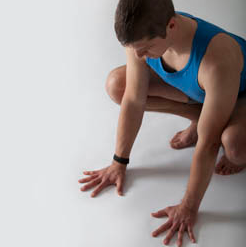
I don't know Laura Riggs, but I bet she is fun to have a drink with. Actually I am surprised she is not from L.A., but in fact she's from Denver. Anyway, she has a chip on her shoulder about corporatized yoga and a biting wit.
Here are her McYoga Sutras, Chapter 1, which I am going to reprint below. But check out her bio: I wonder
where she worked.
Laura started practicing yoga roughly ten years ago and began teaching five years ago. She left a successful career in advertising to teach yoga full-time because she decided it would be totally rad to pretend she was 21 again. She managed two large studios for the past two years, led many teacher trainings, and enjoyed having her soul sucked out of her. Now that the LSD in the Kool-Aid they had her drink before work each day has worn off, she is relieved to be rid of a company that believes first in money and second in “speaking your truth” — so long as it agrees with “our truth” because “our truth” can kick “your truth’s” ass! She does admit there are days that she still checks the studio’s yoga schedule and experiences flashbacks – only to be grateful she no longer has to manage the severely undereducated teachers trying their best to fulfill the studio’s mandate to “Bring the Sexy Back” to yoga. Last time she checked herself, before she wrecked herself, yoga was never sexy to begin with…..
Part 1: Self Absorption
1.1 Now begins the study and practice of McYoga
1.2 McYoga is merely for physical fitness and a means of manifesting money
1.3 The goal of McYoga is never spiritual, period, this is called self absorption
1.4 McYoga’s purpose is to teach the practitioner how to achieve self absorption and that self-identity is an illusion to be overcome.
1.5 At other times, when one is not self absorbed, the follower appears to take on the form of five modifications to conjure the mentality within the McYoga clique
1.6 These five modifications manifest as misconception, gossip, detachment, narcissism, and allegiance
1.7 Misconception is an illusionary knowledge that attending a McYoga studio will help the practitioner live an extraordinary life
1.8 Gossip is the spread of false rumors about those who are “off our path” to standardization of the physical practice
1.9 The practitioner will partake in smoking various plants from the earth to become firmly rooted in complete detachment from reality in order to enjoy attending mind-numbing raves, aka “yoga festivals”
1.10 Narcissism is achieved when the practitioner realizes detachment from others will leave one completely fixated on his/her self
1.11 Allegiance is complete when the practitioner swears loyalty to McYoga as their sole provider of all forms of physical fitness and spends their income on a monthly membership, worthless trainings, mediocre lifestyle programs, and investing in future McYoga locations
1.12 These personality modifications will be mastered through practice and aversion
1.13 McYoga makes it easy to practice 2-3 times daily now that we have 50+ locations open in the US (and another 50 slated to open this year)
1.14 Aversion is realized when one believes that they because they subscribe to McYoga, they have somehow become a better person, all the while behaving like an egomaniacal, judgmental prick
1.15 From that practice, obstacles to successful aversion begin to disappear
1.16 These obstacles are awareness, wise knowledge, empathy, humility, wise action, and honor
1.17 Accompanying these obstacles are frustration, amnesia, judgments, restlessness, disease and injury
1.18 In order to prevent these obstacles from arising, one should habituate themselves in the teaching of McYoga
1.19 By cultivating attitudes of indifference toward suffering, denial toward truth, indulgence toward vice, and anger toward others, the obstacles can be lessened
1.20 Another way to McYoga is the mastery of ignorance
1.21 Without reflection, ignorance is bliss
1.22 Without reflection, the practitioner remains in a state of ignorance to varying degrees
1.23 McYoga is born through the repression of awareness and all individuality is lost












 2
2



